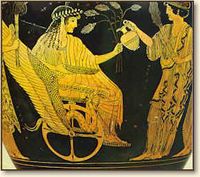.
Mythologische Erfinder: Hephaistos, Daedalus, Talos, Palamedes und andere
Homer describes some inventions of Gods (or other mythical persons), such as selfmoving tripods, doors which open with an accoustical signal, anthropomorphic robots. Different versions of mythological stories exist for various inventions. We of course often don't know who were the first inventors and as the real inventor for example of the saw which the Greeks say was invented by Talos. Today we say that Phoenicians discovered the purple color but according to Julius Pollux (Onomasticon I, 45-49), writing in the second century AD:
purple dye was first discovered by Herakles, or rather, by his dog, whose mouth was stained purple from chewing on snails along the Levantine coast, the area most famous in antiquity for its purple dye. Palaephatus (De Incred 62) also attributes the discovery of purple dye to Herakles and locates it at Tyre in the mid-second millennium BC. King Phoenix received a purple-dyed robe from Herakles and decreed that the rulers of Phoenicia should wear this colour as a royal symbol. Brendan Burke Early purple dye production on Crete
Of course the question is who was this Herakles, the Egyptian Herakles or the Greek Herakles? Foreign Gods imported from other cultures were “hellenized” and obtained a Greek nationality identity, like today athletes who obtain the national identity of foreign countries and their victories are celebrated with patriotic pathos. My interest was only to compile information of some stories about inventors and inventions mentioned in Greek Mythology.
Hephaistos (or Hephaestus)
But Hera without union with Zeus -- for she was very angry and quarrelled with her mate -- bare famous Hephaestus, who is skilled in crafts more than all the sons of Heaven. Hesiod Theogony
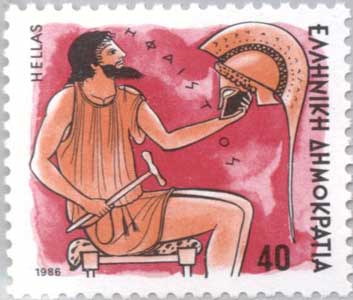
Hephaistos, the husband of Aphrodite and the son of Zeus and Hera, an inventor of various automatic devices. He produced armor for example for Achilles. When Hephaistos was banished from the Olymp after some problems with Hera he was so angry that he sent to his mother Hera a golden throne, which however trapped her as soon as she sat in it. Only when Dionysos made him drunk he accepted to release Hera. As a gift he was allowed to marry Aphrodite and to return to the Olymp. He also used a device to trap Ares the lover of Aphrodite.
There are paintings here -- Dionysus bringing Hephaistos up to heaven. One of the Greek legends is that Hephaistos, when he was born, was thrown down by Hera. In revenge he sent as a gift a golden chair with invisible fetters. When Hera sat down she was held fast, and Hephaestus refused to listen to any other of the gods save Dionysos -- in him he reposed the fullest trust -- and after making him drunk Dionysos brought him to heaven. Pausanias , Description of Hellas
Hephaistos at an early date was paired off with Aphrodite in marriage... Aphrodite could provide increasing population, while her husband Hephaistos contributed the metal tools which the larger population needed in order to increase its agricultural efficiency. But soon it is discovered that metal implements like ploughshares, can be turned into swords, and the practice of warfare becomes institutionalized. Ares is the leader of armies and war god, and subsumes the tool and weapon maker under his more aggressive role, incidentally having a publicly acknowledged affaire with Aphrodite. Hephaistos is no longer essential to the society, and (with his lame leg) becomes a comic figure as the sadly cuckolded husband. William Harris The Discovery and Uses of Metals
Homer describes some inventions of Hephaistos:
Such, converse while they held, to Vulcan's house,
Immortal, starlike bright, among the Gods
Unrivaled, all of brass, by Vulcan's self
Constructed, sped the silver−footed Queen.
Him sweltering at his forge she found, intent
On forming twenty tripods, which should stand
The wall surrounding of his well−built house;
With golden wheels beneath he furnished each,
And to the assembly of the Gods endued
With power to move spontaneous, and return,
A marvel to behold! thus far his work
He had completed; but not yet had fixed
The rich−wrought handles; these his labour now
Engaged, to fit them, and to rivet fast.
While thus he exercised his practised skill,
The silver−footed Queen approached the house.
Charis, the skillful artist's wedded wife,
Beheld her coming, and advanced to meet;
And, as her hand she clasped, addressed her thus:
There waited on their King the attendant maids;
In form as living maids, but wrought in gold;
Instinct with consciousness, with voice endued,
And strength, and skill from heavenly teachers drawn.
These waited, duteous, at the Monarch's side,
His steps supporting; he, with halting gait,
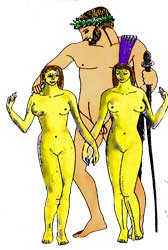
Hephaistos with his golden “robots”
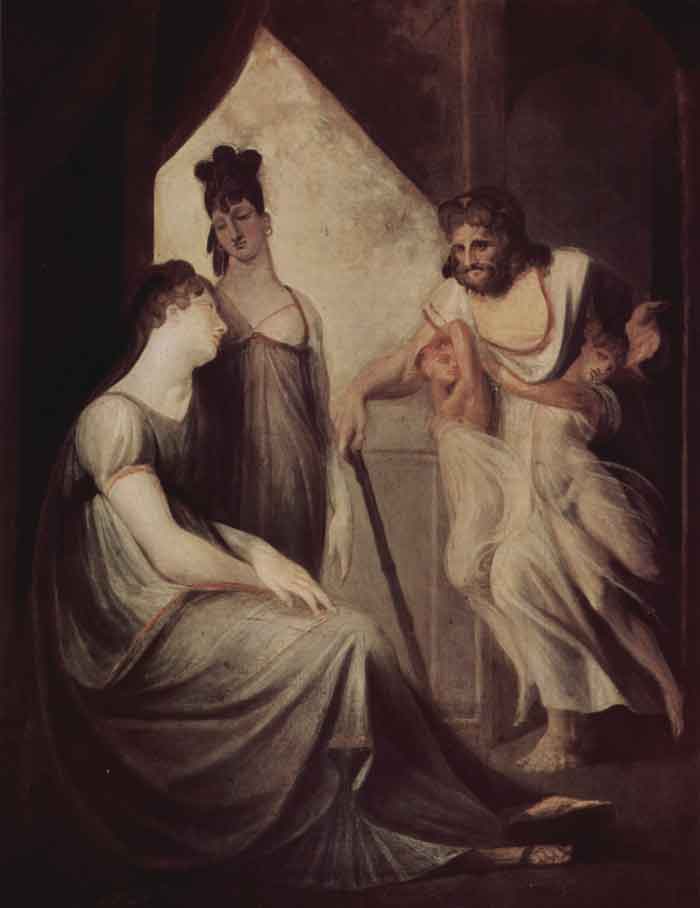
Thetis asks Hephaistos to produce armour for her son Achilles (Johann Heinrich Füssli 1803 ). Hephaistos shown with his his golden "robots"
She said: and Pallas, blue−eyed Maid, complied.
Offspring of Saturn, Juno, heavenly Queen,
Herself the immortal steeds caparisoned,
Adorned with golden frontlets: to the car
Hebe the circling wheels of brass attached,
Eight−spoked, that on an iron axle turned;
The felloes were of gold, and fitted round
With brazen tires, a marvel to behold;
The naves were silver, rounded every way:
The chariot−board on gold and silver bands
Was hung, and round it ran a double rail:
The pole was all of silver; at the end
A golden yoke, with golden yoke−bands fair:
And Juno, all on fire to join the fray,
Beneath the yoke the flying coursers led.
Then Juno sharply touched the flying steeds:
Forthwith spontaneous opening, grated harsh
The heavenly portals, guarded by the Hours,
Who Heaven and high Olympus have in charge
To roll aside, or draw the veil of cloud.
Through these th' excited horses held their way.
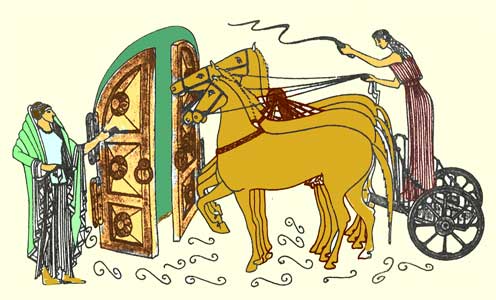
The doors of Olymp open automatically (acoustically) so that Hera can enter with her chariot
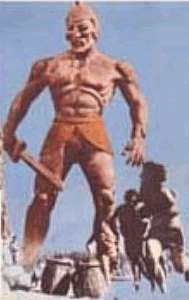
Talos according to Ray Harryhausen in the movie Jason and the Argonauts.
Talos (i.e. Sun Cretan) was a giant metallic robot in Greek Mythology that was build by Hephaistos to protect the island of Crete. It was able of touring the island of Crete three times each day. Images from Coins and Pottery exist but Harryhausen probably provided the best reconstruction. Talos was destroyed by the Argonauts by opening a valve from which Talos lost his hydraulic fluid or blood (by Medea) but different versions of the story exist
Hephaestus produced the armor for Achilles, the chariot of Helios, the bow of Eros, the winged helmet and sandals of Hermes and many other products for the Olympians.
Daidalos (or Daedalus) of Athens
989 BC. Daedalus and his nephew Talus invent the saw, the turning-lath, the wimble, the chipax, and other instruments of Carpenters and Joyners, and thereby give a beginning to those Arts in Europe. Daedalus also invented the making of Statues with their feet asunder, as if they walked. Sir Isaac Newton, A short chronicle: From the First Memory of things in Europe to the Conquest of Persia by Alexander the Great
Daedalus was the son of Alcippe and Eupalamus ('skillful') or Metion ('knowledgeable') the most famous inventor (he was said to be descendent from Hephaistos). Daedalus sister was Polycaste and her son Talos (or Calus according to Pausanias) . Talos invented the saw at the age of 12 years. He picked up the spine of a fish and with it proceeded to cut a stick in half. Finding this to be a handy tool, he copied his invention in iron, hence creating the first saw. Others say that he had the idea from the teethes of a snake. Talos also invented the potter's wheel and the compass that is used to draw circles. These inventions made Talos so famous that people ignored Daedalus who decided to kill Talos as he did. Talos mother Polycaste committed suicide after the death of her son. Daedalus escaped the punishment and took refuge at the court of King Minos of Crete, where he was welcomed as a famous craftsman.
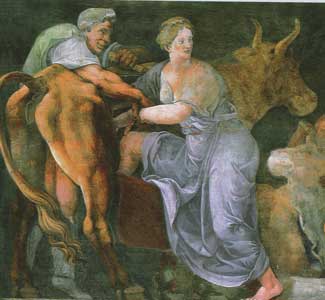
Pasiphae entrers in Daedalus wooden cow, Giulio Romano c.1530. (A more terrible use was the real bronzen bull device build by Perillus of Athen, See: Phalaris) But angry at him for not sacrificing the bull, Poseidon made the animal savage, and contrived that Pasiphae should conceive a passion for it. In her love for the bull she found an accomplice in Daedalus, an architect, who had been banished from Athens for murder. He constructed a wooden cow on wheels, took it, hollowed it out in the inside, sewed it up in the hide of a cow which he had skinned, and set it in the meadow in which the bull used to graze. Then he introduced Pasiphae into it; and the bull came and coupled with it, as if it were a real cow. And she gave birth to Asterius, who was called the Minotaur. He had the face of a bull, but the rest of him was human; and Minos, in compliance with certain oracles, shut him up and guarded him in the Labyrinth Apollodorus, Library and Epitome 3.1.4
Pasiphae, the wife of Minos asked Daedalus to construct an instrument that would allow her to consummate the relationship she was having with a beautiful white bull of Poseidon. Daedalus produced a wooden cow that would enable the Queen to hide inside it's hollow stomach and thereby receive the object of her desire. The bull was fooled by the disguise and Pasiphae soon conceived a child as a result of this union. The child was the Minotaur, a half man half bull creature. Minos in order to hide the child from the Cretans, as it was obviously not his, asked Daedalus to construct a maze-like prison (the famous Labyrinth) for the Minotaur.
Seven maidens and seven youths were offered as a sacrifice to the Minotaur every nine years (what exactly the Minotaur did is not clear as as a bull he was probably a vegetarian). One year among these seven young men there was Theseus, the son of Aegeus. Ariadne in love with Theseus asked Daedalus to help Theseus to find a way out of the Labyrinth. He gave to her a ball of thread and instructed her to have Theseus tie one end to the entrance of the maze before entering. He was then to allow the ball to unwind as he made his way through the Labyrinth to find the Minotaur. By following the trail of twine that he left behind him he could find the way out of the Labyrinth.
Theseus killed the Minotaur. Daedalus and his son Icarus were imprisoned for helping Theseus. Daedalus in order to escape from the prison created two pairs of wings out of bird feathers, thread and wax. Fitting the one pair to Icarus' body, Daedalus warned his son to be careful not to fly too close to the sun for the heat would melt the wax holding the feathers together.
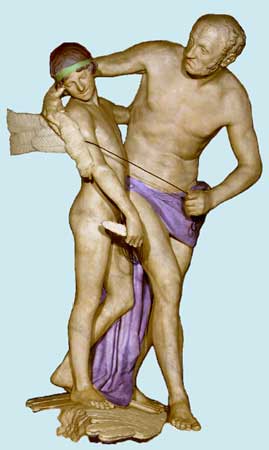
Ovid describes the flight of Daedalus and Icarus: "Some fisherman, perhaps plying with his quivering rod, some shepherd leaning on his staff, or a peasant bent over his plough handle caught sight of them as they flew past and stood stock still in astonishment, believing that these creatures who could fly through the air must be gods."
Brueghel Pieter the Elder, Fall of Icarus
Icarus forgot his father's words of warning, flying closer and closer to the shining sun he lost one by one his feathers. He was killed falling into the Aegean sea. Daedalus found the body of Icarus who was buried in a place knowns as Icaria. Daedalus then flew off to Sicily where he was welcomed by the King. Minos tried to find Daedalus. He let the word be spread that he would give a great prize to anyone who could pass a thread through a closely spiraled shell assuming that only Daedalus could do this. Daedalus in Sicily found a solution for the problem of Minos. He drilled a hole in the closed end of the shell and attached a thread to the body of an ant. He then smeared the opened of the shell with honey and placed the ant inside closing the hole behind him. As the ant tunneled to reach the honey, he also threaded the shell through all of it's twists and turns. Minos knew that this solution was that of Daedalus and he sailed to Sicily asking without success there the King of Sicily to hand over Daedalus. After a battle Minos was killed.
The Story of Pasiphae, Theseus and the Minotaur
Some of the inventions and work of Daedalus from various sources
Daidalos, the greatest maker of statues, was the first to open their eyelids, so that they appear to see, and to separate the feet, so that they appear to walk. And because of this he bound them, in order that they might not run away, as if they were living and breathing, Scholiast on Plato Meno
Daedalus invented the axe, the awl, and the bevel, sails for ships, a folding chair in the temple of Athena Polias Athens. He was the first to represent open eyes, legs separated in stride, and arms and hands extended in statues. He cultivated building art, stone working and statue making. (Diodorus)
According to Pausanias he created the wooden image of Heracles in sanctuary of Athena Chalinitis in Corinth. He is responsible for another wooden Heracles on the border of Arcadia and Messenia, now in a Hermaeum. He created an image in an Oracle and a wooden Heracles in the sanctuary of Heracles in Boeotia. He is the man behind the image of Heracles in Thebes. He produced two wooden images in Crete. He created the statue of Britomartis at Olus. He is the mind behind a wooden image of Aphrodite on Delos. He is responsible for the construction of the Oracle of Trophonius at Lebadeia. He was the inspiration behind an Athena at Cnossus. He is the architect of Temple of Apollo in Cumae. He created the Propylon at the temple of Hephaestus in Memphis, and statue of himself in the same temple. He was behind the gymnasia and courts of justice in Sardinia. He produced the Holumbethra (a swimming bath, reservoir or a lock) in Megaris in Sicily.He turned the royal residence of King Cocalus into an impregnable fortress. He planned a sauna in a grotto in Selinus, possibly with curative properties. He created a golden ram for Aphrodite on Mount Eryx.
Palamedes
1200 BC? Sophocles claimed dice were invented by Palamedes during the siege of Troy. Palamedes of Argos some say invented eleven letters of the alphabet or, as others say even sixteen. Palamedes is assumed to have discovered counting and coinage, weights and measures (attributed also to Hermes), military ranks and the game of pessoi (a forerunner of chess). Palamedes was killed directly or indirect by Odysseus. Herodotus attributed the discover of the dice to the Lydians in the reign of Atys. Probably dice were known and invented independently in various places back up to 6000 BC. Romans believed that Fortuna the daughter of Zeus decided about the outcome of a throw. Egyptians believed that their god Theuth invented dice and also numbers, arithmetic, geometry, astronomy, etc.
Philoctetes
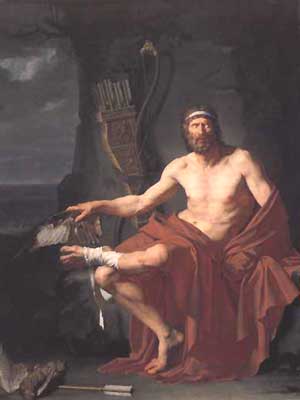
Philoctetes on Lemnos, 1788, Jean-Germain Drouais (1763 - 1788), (1.76 m x 2.25 m) Chartres, Musée des Beaux-Arts, Another ancient Greek like Oedipus having health problems with his foot.
Philoctetes, whose story has been treated elsewhere, was a master- archer, perhaps inventor of some new type of bow, such as the bow with bent -back curvature at the tips for a secondary spring effect, which is a kind of bow that Homer mentions. But he is rejected by the army storming Troy, left on a desert island on the weak excuse that he had a badly infected foot which represented a curse, and only when the military realize that they need his weapon, is there any attempt to make a reconciliation with him William Harris, Man the Inventor of Tools
Boutades

Joseph-Benoit Suvee, Invention of the Art of Drawing, 1791, 2.67 m x 1.32 m, Groeninge Museum, Bruges
According to a legend the first figurine in clay was produced by Boutades, a Sikyonian potter at Corinth thought to have lived before 657 BC. Boutades produced the figurine on behalf of his daughter, "who was in love with a young man; and she, when he was going abroad, drew in outline on the wall the shadow of his face thrown by a lamp. Her father, having pressed clay onto this, made a relief that he hardened by exposing it to fire along with the rest of his pottery" Pliny. The daughter of Boutades sketched the outline of a boy’s shadow, cast on the wall by lamplight as he slept. Delighted with the perfection of the likeness, Boutades cut out the shape, filled in the outline with clay and made a model that he dried and baked (Pliny 35. 151-152 and Athenagoras, Legatio pro Christianis 17). Antonio Corso The Position of Portraiture in Early Hellenistic Art Criticism
Musical Instruments
The Lyre, with 3 strings, according to mythology was invented by Hermes and was given to Apollo (who some say added another 4 strings). Hermes. at the age of one day (!!!), climbed out of his cradle and he found the shield of a turtle. He stretched the skin of a cow around it, fixed two horns through the holes were once the paws of the animal stood and he tied strings at the horizontal connection between the arms. The cow was taken from the cattle of his brother Apollo who was angry until Hermes offered him the lyre.
There is a meaning also in the myth of the ancients, which tells how Athene invented the flute and then threw it away. It was not a bad idea of theirs, that the Goddess disliked the instrument because it made the face ugly; but with still more reason may we say that she rejected it because the acquirement of flute-playing contributes nothing to the mind, since to Athene we ascribe both knowledge and art. Aristotle, Politics
Optimized flying devices:
Airbus tried to reduce the weights of their airplanes (especially the giant version tested this year). I guess that even the ancient Greeks knew that weight reduction is important: A weight optimized mythological flying device (with a drink from a stewardess for Triptolemos, before the flight).
LINKS
William Harris, Man the Inventor of Tools http://community.middlebury.edu/~harris/SubIndex/greekmyth.html
Jacob E. Nyenhuis, Myth and the Creative Process: Michael Ayrton and the Myth of Daedalus, the Maze Maker
| Ancient Greece
Science, Technology , Medicine , Warfare, , Biographies , Life , Cities/Places/Maps , Arts , Literature , Philosophy ,Olympics, Mythology , History , Images Medieval Greece / Byzantine Empire Science, Technology, Arts, , Warfare , Literature, Biographies, Icons, History Modern Greece Cities, Islands, Regions, Fauna/Flora ,Biographies , History , Warfare, Science/Technology, Literature, Music , Arts , Film/Actors , Sport , Fashion --- |

